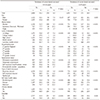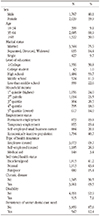Abstract
Objectives
The purpose of this study was to investigate effective predictive factors of the persistence of unmet dental care needs.
Methods
Data were obtained from the Korea Health Panel studies of 2011 and 2015, and 4,406 subjects, aged 18 years or older, were included in this study. Of these subjects, those who persistently experienced unmet dental care needs over the three-year period were identified. Panel logistic regression analyses were conducted to identify socio-demographic and health-related factors associated with the persistence of unmet dental care needs in two groups, those aged between 18–64 years and over 65 years.
Figures and Tables
Table 2
Difference of persistence of unmet dental care need according to general characteristics by age

References
1. Kim N, Kim CY, Shin H. Inequality in unmet dental care needs among South Koreana adults. BMC Oral Health. 2017; 17:80.

2. Chae S, Lee Y, Kim J, Chun KH, Lee JK. Factors associated with perceived unmet dental care needs of older adults. Geriatr Gerontol Int. 2017; 17:1936–1942.

3. Park HJ, Lee JH, Park S, Kim TI. Changes in dental care access upon health care benefit expansion to include scaling. J Periodontal Implant Sci. 2016; 46:405–414.

4. Kim YH, Lee JH. Relationship between unmet dental needs and general and oral health status of adults. J Korean Acad Oral Health. 2018; 42:16–23.

5. Huh SI, Lee HJ. Unmet health care needs and attitudes towards health care system in Korea. Korean J Health Econ Policy. 2016; 22:59–89.
6. Kim SJ, Huh SI. Financial burden of health care expenditures and unmet needs by socioeconomic status. Korean J Health Econ Policy. 2011; 17:47–70.
7. Korea Centers for Disease Control and Prevention. 2016 Korea National Health and Nutrition Examination Survey: VII-1. Survey Report. Seoul: Korea Centers for Disease Control and Prevention;2016. p. 122.
8. Jeon JE, Chung WG, Kim NH. Determinants for dental service utilization among Koreans. J Korean Acad Oral Health. 2011; 35:441–449.
9. Yoo SH, Park IS, Kim YM. A decision-tree analysis of influential factors and reasons for unmet dental care in Korean adults. Health Soc Welf Rev. 2017; 37:294–335.

10. Kang JH, Kim CW, Kim CS, Seo NK. Unmet dental care needs according to employment status. J Korean Acad Oral Health. 2015; 39:56–62.

11. Kim NH, Jeon JE, Chung WG, Kim DG. Social determinants related to the regional difference of unmet dental need in Korea. J Korean Acad Oral Health. 2012; 36:62–72.
12. Calvasina P, Muntaner C, Quiñonez C. Factors associated with unmet dental care needs in Canadian immigrants: an analysis of the longitudinal survey of immigrants to Canada. BMC Oral Health. 2014; 14:145.

13. Wallace NT, Carlson MJ, Mosen DM, Snyder JJ, Wright BJ. The individual and program impacts of eliminating Medicaid dental benefits in the Oregon Health Plan. Am J Public Health. 2011; 101:2144–2150.

14. Jang Y, Yoon H, Park NS, Chiriboga DA, Kim MT. Dental care utilization and unmet dental needs in older Korean Americans. J Aging Health. 2014; 26:1047–1059.

15. Yu SM, Bellamy HA, Kogan MD, Dunbar JL, Schwalberg RH, Schuster MA. Factors that influence receipt of recommended preventive pediatric health and dental care. Pediatrics. 2002; 110:e73–e73.

16. Calzón Fernández S, Fernández Ajuria A, Martín JJ, Murphy MJ. The impact of the economic crisis on unmet dental care needs in Spain. J Epidemiol Community Health. 2015; 69:880–885.

17. Giedion U, Andrés Alfonso E, Díaz Y. The impact of universal coverage schemes in the developing world: a review of the existing evidence. The world Region:World Bank;2013. p. 1–8.
18. Kim H, Kang M. A multilevel analysis on unmet healthcare need and regional contextual effects: A case study of seoul. Korean J Health Econ Policy. 2018; 24:111–141.
19. Guessous I, Theler JM, Izart CD, Stringhini S, Bodenmann P, Gaspoz JM, et al. Forgoing dental care for economic reasons in Switzerland:a six-year cross-sectional population-based study. BMC Oral Health. 2014; 14:121.

20. Moon JH, Kang MA. The prevalence and predictors of unmet medical needs among the elderly living alone in Korea. Health Soc Welf Rev. 2016; 36:480–510.
21. Lahelma E, Martikainen P, Laaksonen M, Aittomäki A. Pathways between socioeconomic determinants of health. J Epidemiol Community Health. 2004; 58:327–332.

22. Choi HJ. Catastrophic health expenditure and unmet needs of lowincome households depending on the types of healthcare system. [dissertation]. Seoul: Seoul National University;2017. [Korean].




 PDF
PDF ePub
ePub Citation
Citation Print
Print




 XML Download
XML Download